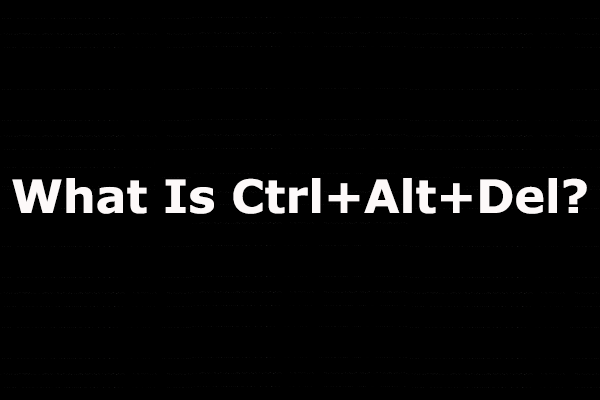Control-Alt-Delete (often abbreviated to Ctrl+Alt+Del, also known as the 'three-finger salute' or 'Security Keys') is a computer keyboard command on IBM PC compatible computers, invoked by pressing the Delete key while holding the Control and Alt keys: Ctrl + Alt + Delete. Beginning with Windows Server 2008 and Windows Vista, the CTRL+ALT+DELETE key combination is required to authenticate if this policy is disabled. Group Policy This policy setting can be configured by using the Group Policy Management Console (GPMC) to be distributed through Group Policy Objects (GPOs).
- Ctrl Alt Delete Function
- Windows Ctrl Alt Delete
- Ctrl Alt Delete Function Key
- Ctrl Alt Delete Functions
- Is There Ctrl Alt Delete Function For Macs
Bill Gates recounts the history of how Ctrl Alt Del came to be.
(Credit:Harvard/Screenshot by CNET)Microsoft co-founder Bill Gates has admitted what quite a few Windows users have been thinking for a long time: control-alt-delete is an unnecessary mechanism.
Give us a single button, Gates said. But it wasn't to be.
(Credit:Harvard/Screenshot by CNET)Speaking in a broad interview at Harvard over the weekend, Gates said that the control-alt-delete function, which allows users to log in to Windows and access the task manager (you may be most familiar with it as the first step in rebooting), was conceived after an IBM keyboard designer wouldn't give him a single button to perform the same chore. (That part of the conversation starts at about 16:45 in the video embedded below.)
'So we could have had a single button, but the guy who did the IBM keyboard design didn't want to give us our single button,' Gates said. 'So we had, we programmed at a low level -- it was a mistake.'
As big a mistake as it might have been, the function lived on through generation after generation of Windows. This marks the first time that Gates has so forcefully acknowledged that the feature wasn't necessarily the best idea.
The function was created by IBM PC designer David Bradley as a way for computer users to reboot their machines. In an interview with CNET recently, Bradley said he didn't understand why Gates and Microsoft decided to make it a log-in feature, adding that 'I guess it made sense for them.'
If you've recently switched to Mac from Windows, you'll no doubt have wondered if there's a Ctrl-Alt-Del equivalent for Mac. The command brings up a menu that is used on Windows to terminate a program/task, or reboot a system. You can even choose to sign out of your account or switch to another one. So, basically, it's a universal fix.
How to press Ctrl Alt Delete on a Mac? There's no exact keyboard shortcut that performs the same task as Ctrl+Alt+Delete does on Windows, but you can achieve similar results on Mac — at least with terminating apps — through different commands.
Improved force quit on Mac
The Mac version on Ctrl-Alt-Delete: Grab the best tools for force quitting, effortlessly
There are at least five ways to close programs on Mac via Force Quit. You can use Terminal, a keyboard shortcut, the Apple Menu, Dock, or Activity Monitor, all of which will represent ctrl alt del equivalent for Mac.

In this article, we take a look at all the known ways of using the Mac version of Control Alt Delete.
How to Ctrl-Alt-Delete on a Mac
The simplest answer to 'How do you control alt delete on a Mac keyboard?' would be to use Force Quit. And guess what, there's a shortcut for that as well.
So here's how to do Ctrl Alt Delete on a Mac:
- Press ⌘+Option+Esc and you'll bring up the Force Quit dialog box. This can be used at any time but, given that you can quit any app by making it active and pressing ⌘+Q, the only time you'll need it is when an app stops responding or starts beachballing. The command would still works when the app is in full-screen mode.
- Once you've called up the dialog box, you'll see a list of currently running apps. Usually the one that's causing a problem will be labelled as not responding.
- Select the non-responding app and press Force Quit.
If you don't want to memorize the shortcut, there's an easy way to perform the same action via the Apple menu: Click on the Apple logo in the upper left corner > Force Quit > select the app and force quit (the equivalent of ctrl alt del on Mac).
Tip: If apps regularly become unresponsive or start hogging processor cycles, iStat Menus can help get to the bottom of what's causing the problem. It will show you which apps are using the biggest CPU cycles. And if you need more information, you can launch Activity Monitor directly from the iStat Menus app.
All other alternatives for Ctrl+Alt+Del on a Mac
How to perform 'Ctrl-Alt-Delete' on Mac?
There are a couple of other force quit shortcuts to unfreeze app on Mac:
- Dock. If you hold down the Control and Option keys, and click on an app's icon in the Dock, you'll see Force Quit listed as an option in the menu that pops up. Select it and the app should force quit.
- Activity Monitor. You can double-click on any application in the Activity Monitor to bring up a separate window with more information about it and the Quit option to close it.
- Apple Menu. The third way to do the equivalent of control alt delete on a Mac keyboard is to click on the Apple menu and select Force Quit. This will bring up the Force Quit dialog box and you can select the unresponsive app from there.
- Terminal. If the basic methods don't work, you can access Terminal utility in the Applications and type the force quit command:
- Type 'top' and press the Return button. You'll see the information about all the apps that are active at the moment.
- In the Command column, find the name of the app you want to terminate and make a note of its PID number (right on the left).
- Type 'q' to return to the command line.
- Type 'kill111' (replacing 111 with the PID number) — this will perform force quit on Mac for the selected program.
- Quit Terminal.
Once you learn how to force quit an app on Mac, here are two quick ways to relaunch it:
Ctrl Alt Delete Function
- Click on the app icon if it's in the Dock.
- Click on the magnifying glass in the top right corner, type the name of the app, and click on it once it appears.
What do you do when application won't Force Quit
Sometimes it's not just one app that's unresponsive. What to do when your Mac freezes? How do you start Task Manager on a Mac?
To fix browser freezing — let's say, if you can't quit Safari — it would be enough to go into Activity Monitor and kill Safari processes. But if the whole system is not responding and force quit doesn't work on Mac, you'll have to give it a fresh start.
Windows Ctrl Alt Delete
Unlike Windows macOS doesn't use the typical Ctrl-Alt-Delete shortcut to choose frozen programs to Force Quit. If you have a frozen Mac that won't do anything and you can't use any of the methods above to force quit (tip: you can force quit the Finder if it's misbehaving — it's just an app), you need to force it to restart.
Simple steps to fix force quit not working on Mac:
- Hold down Command and Control and press the power button to restart it. If you have a MacBook Pro with a Touch Bar, that won't work. You'll need to force it to shutdown and then start it normally. You do that by holding down the power button for five seconds. Your Mac will then forcibly shut down.
- You can restart your Mac again by waiting a few seconds and pressing the power button.
This is not the most time-efficient option, but it's definitely helpful to know how to close all apps on Mac.
How to check performance with Activity Monitor
If your Mac is running slowly, but all your apps are still working, or if the fans seem to run more often than normal or are louder than usual, there may be a process hogging CPU cycles. Seems it is a good time to peek inside the processes running on your computer. You can use Mac Activity Monitor shortcut to discover the culprit.
Ctrl Alt Delete Function Key
Here's how to start task manager on Mac:
- Launch Activity Monitor from the Utilities folder in your Applications folder and click the CPU tab.
- Make sure the arrow next to CPU% is pointing down. If not, click it.
- If there are any apps or processes using up significant CPU cycles (more than half), they may be causing a problem. You can quit them if you select the app or stop process (it could be a Safari tab) and press the X in the toolbar.
All in all, there is no direct equivalent of pressing Ctrl+Alt+Delete on a Mac but by using a combination of the Force Quit function and Activity Monitor tool you can not only end task on Mac, but actually achieve a more informed result. And if you'd like to have even more control over your Mac, use iStat Menus to get all the up-to-date information. You can download and try iStat Menus for free from Setapp and see what's slowing down your Mac right now.
Setapp lives on Mac and iOS. Please come back from another device.

Meantime, prepare for all the awesome things you can do with Setapp.
Read onSign Up
Ctrl Alt Delete Functions
Setapp uses cookies to personalize your experience on our website. By continuing to use this site, you agree to our cookie policy.